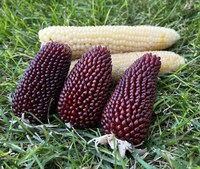Dakota Gardener: A popping experiment
(Click an image below to view a high-resolution image that can be downloaded)
By Carrie Knutson, Horticulture agent
NDSU Extension – Grand Forks County
Did you try to grow anything new in your garden this growing season? If you are a regular reader of this column, you know I usually try to grow a new fruit or vegetable at home or in my school gardens. I had great success with okra last year. This year I decided to try something new at home. It is neither a fruit nor a vegetable, it is a grain.
My family loves popcorn and while cruising the seed packets at the local garden center, I spied some popcorn seeds. I thought let’s try growing some this year. It was a last-minute impulse and I should have done a bit of research first. As a result, I will share some tips to help make your popcorn-growing experience easier.
Popcorn, scientifically known as Zea mays everta, is different than our typical sweet and field corn. The outside of the kernel is tough, and the inside is starchy and has some moisture. The moisture is important as it is what allows the kernels to burst or “pop” when they are heated.
Corn is a cross-pollinated crop. This means pollen from the tassels (male flower) of one plant can land on and fertilize the silks (female flower part) of a different plant. This isn’t a bad thing if you have the same variety of corn planted nearby. If you have different types of corn close together, the kernels will have different characteristics than the seed you planted. Consequently, popcorn must be isolated from other sweet or field corn plantings to prevent any popping issues.
Corn pollen can be carried by the wind and by insects. To ensure you have the best popping corn, isolate your patch by a distance of 300 feet. This is where the research comes in for my popcorn crop. I planted the popcorn next to sweet corn. I had some interesting cobs as a result.
You can also plant popcorn first as it takes more time to mature and then plant sweet corn a couple of weeks later. Corn seed germinates best when the soil temperatures are warm, about 60 degrees Fahrenheit. Plant popcorn seeds in a grouping of at least four rows.
Rows can be spaced 18 to 24 inches apart. Follow the directions on the seed packet for seed depth and spacing in the rows. Be patient. Popcorn can take a long time to germinate and emerge from the ground. Trust me, patience is key. I thought about reseeding several times before the seedlings emerged.
Leave your popcorn cobs to dry in the garden as long as possible. It will probably be one of the last crops you harvest. The quality of the popcorn will depend on the moisture level at which it is stored.
You can try popping a few kernels every couple of weeks. High moisture kernels will have popcorn that is tough and chewy. Once you have the perfect consistency, you can shell the kernels from the cobs and store them in sealed airtight containers.
There are lots of different popcorn varieties to choose from. Make sure to select a variety that will mature during your growing season. The NDSU Extension Home Garden Variety Trials recommend Dakota Black for popcorn varieties.
I tried Japanese Hulless and Strawberry popcorn this year with surprisingly good results. If you have a good popcorn variety to share, drop me a “kernel” and let me know. Happy gardening!
NDSU Agriculture Communication – Nov. 13, 2024
Source: Carrie Knutson, 701-780-8229, carrie.knutson@ndsu.edu
Editor: Kelli Anderson, 701-231-6136, kelli.c.anderson@ndsu.edu




